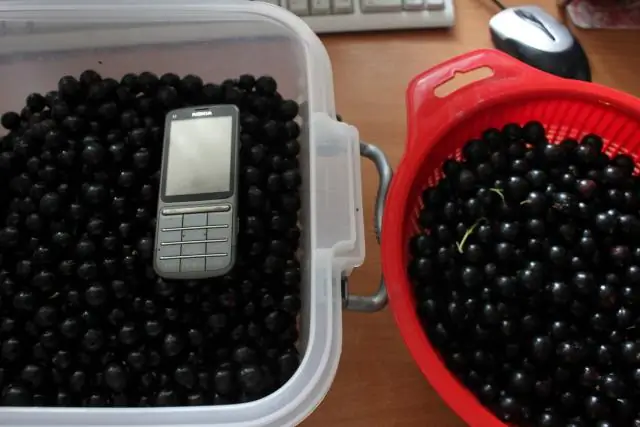
Table of contents:
- Author Bailey Albertson [email protected].
- Public 2023-12-17 12:53.
- Last modified 2025-01-23 12:41.
How to grow a black apricot in the garden

Apricot trees are no longer a rarity in Russian gardens. The fruits of yellow, white, red and even black are familiar to summer residents. And if the first varieties of black apricot could be grown without much risk only in the southern regions, now there are those that tolerate winter well in the middle lane, are resistant to frost and diseases.
Content
-
1 What is black apricot
- 1.1 Features of black apricot - video
- 1.2 Advantages and disadvantages - table
-
2 Description of varieties
- 2.1 Black Prince
- 2.2 Black velvet
- 2.3 Melitopol black
- 2.4 Korenevsky black
- 2.5 Mouse (Hummingbird)
- 2.6 Luhansk black
- 3 Reviews of gardeners
What is black apricot

Black apricot - a hybrid of cherry plum and apricot
Black apricots are varieties that appeared due to the crossing of apricot and cherry plum. It is interesting that initially it was a spontaneous process, and only after discovering extraordinary fruits, scientists began to study the plant and develop new varieties. The tree looks more like an apricot, but it blooms late, like cherry plum. For most regions of Russia, this is a winning feature, since the flowers will not be affected by spring frosts.
A tree of medium height, branched. The flowers of the apricot bush (as these varieties are sometimes called) are white or pale pink in color. By the time of ripening, the fruits change color from green to purple, burgundy, brown, dark purple. The skin is fluffy. Sweet, but sour, they have a typical apricot smell. The stone is poorly separated from the pulp.
Features of black apricot - video
Advantages and disadvantages - table
| Benefits | disadvantages |
| Black apricot is more resistant than common apricot to diseases of fruit trees: moniliosis, clasterosporium disease, cytosporosis. | They are inferior to ordinary apricots in taste, the fruits can be watery or fibrous. |
| The apricot tree is self-pollinated, so one tree on the site is enough to get fruit. In addition, it can be pollinated by other related crops - plum, apricot, cherry plum. | The fruits of black apricot are more tart, with a sour taste, but due to this they are well suited for making jam. |
| Black apricots tolerate frosts well, bloom later than their yellow counterparts, therefore they are not damaged by spring frosts. | They are inferior in yield to their "parents" - apricot and cherry plum. |
| The trees are smaller and shorter and easier to care for. | Fruits are smaller than those of a common apricot - about 20-30 g. |
| They adapt better and faster to external conditions. | In most varieties, the bone does not separate well from the pulp. |
Description of varieties
Black Prince

The color of the Black Prince is far enough from black
The Black Prince was bred in the city of Artemovsk (Donetsk region). This is the most productive black apricot variety. The fruits are burgundy with a bright apricot aroma, the flesh is red, not very dense and juicy. They ripen in the first decade of August. In the southern regions, the weight of fruits reaches 90 g. The variety is perfect for conservation and for fresh consumption, as it has a dessert taste. The tree is easily self-pollinated. However, in comparison with other varieties, the Black Prince is less frost-resistant, the fruits have poor transportability, and are prone to cracking.
Black velvet

Black velvet produces juicy and sweet fruits with a slight sourness
This is the most winter-hardy variety. In addition, it is highly resistant to fungal diseases. Poorly tolerates drought, however, with an excess of moisture, the roots can rot. The yield is high. The plant is small, the crown is not thickened, which makes it easier to care and harvest. Fruits are round-oval in shape with a spike at the stalk, purple in color, the flesh is yellow, juicy, with an apricot aroma, the acidity is practically invisible. The skin is slightly velvety to the touch. The mass is small - about 30 g. Ripen in early August. Apricots are stored for a long time (they can lie in the cellar for 3 months) and are well transported.
Melitopol black

Melitopol black ripens in the third decade of July
The most unpretentious and early maturing variety. Resistant to cold and disease, but more susceptible to moniliosis than others. The trees are tall, grow quickly (branches stretch up to 60 cm per season). Oval fruits of dark red color ripen in the third decade of July. The pulp is bright red, juicy, with a honey flavor, sweet, with a delicate aroma. The weight for a black apricot is impressive - up to 50 g.
This variety is distinguished by its unpretentiousness to growing conditions and a high degree of adaptation to their changes.
Korenevsky black

Korenevsky black gives a bountiful harvest of large fruits
It is resistant to cold and fungal diseases. The crown is thickened. Fruits are spherical, dark purple in color, weighing up to 50 g. The flesh is claret, it tastes more like cherry plum, there is a noticeable sourness. The harvest is abundant. Korenevsky black requires a sufficient amount of phosphorus and potassium in the soil, otherwise the fruits will not ripen.
Mouse (Hummingbird)

The mouse is successfully raised in central Russia
The smallest variety is no more than 3 meters. However, the fruits are also small - about 30 g. The apricots are red-purple, almost without fluff, the flesh is yellowish, with a sweet and sour taste and a wonderful aroma. The variety tolerates winter well.
Luhansk black
The variety is the result of folk selection. Possesses high resistance to cold, fungal diseases, tolerates drought well. But he is picky about the quality of the soil (he likes sandy, slightly alkaline or neutral lands). Fruits 25-30 g, strongly pubescent, black-purple, dense and not very juicy, dark red pulp with a sour taste and mild aroma. Early harvest - at the end of July. The fruits are poorly stored and do not have good transportability.

Luhansk black - one of the early maturing varieties
Gardeners reviews
Svetik84
https://www.forumdacha.ru/forum/viewtopic.php?t=8
Larissa
https://otvet.mail.ru/question/31170615
zamazkina
https://dacha.wcb.ru/index.php?showtopic=49525
AlikaVikt
https://chudo-ogorod.ru/forum/viewtopic.php?t=975
Winnie the Pooh
https://www.forum-volgograd.ru/showthread.php?t=255937
Black apricot feels good in central Russia, is frost-resistant and has a high resistance to fungal diseases of stone fruits. Late flowering of these plants helps avoid ovary loss during the spring frost. Due to these qualities, as well as the pleasant taste and unusual appearance, varieties of black apricots are becoming more and more popular.
Recommended:
Raspberry Varieties Brusvyana: Description And Characteristics, Advantages And Disadvantages, Planting And Care Features + Photos And Reviews

The subtleties of growing raspberries of the Brusvyana variety: description, rules for planting and caring for a plant, main diseases and pests. Gardeners reviews
Pear Varieties Prominent: Description And Characteristics, Advantages And Disadvantages, Planting And Care Features + Photos And Reviews

Description of pear variety Prominent. Advantages and disadvantages. Features of planting and care. Treatment and prevention of diseases and pests. Harvesting. Video. Reviews
Raspberry Varieties Yellow Giant: Description And Characteristics, Advantages And Disadvantages, Planting And Care Features + Photos And Reviews

Description of the raspberry variety Yellow giant, advantages and disadvantages. Planting and care, diseases and pests, gardeners reviews
Sweet Cherry Varieties Bryansk Pink: Description And Characteristics, Advantages And Disadvantages, Planting And Care Features With Photos And Reviews

Characteristic features of the sweet cherry variety Bryanskaya pink, advantages and disadvantages, secrets of choosing a seedling, planting and care
Black Currant Selechenskaya And Selechenskaya 2: Description Of Varieties, Advantages And Disadvantages, Planting And Care Features + Photos And Reviews

Description and characteristics of black currant varieties Selechenskaya and Selechenskaya-2. Advantages and disadvantages, as well as planting and care features
